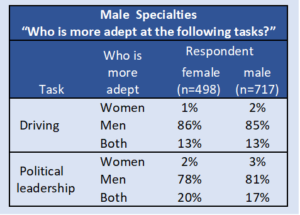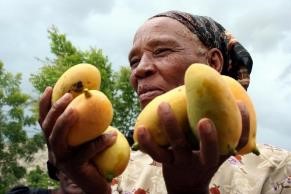In this paper I take a look at how NGO use of “asosyasyson”–what might better be called cooperatives–have probably hurt the economic autonomy of rural Haitian women. Specifically I look at USAID/Coca Cola/IDB funded Haiti Hope Mango project. The project was implemented by TechnoServ. I don’t mention it here, but we’ve observed a similar phenomenon with fishing associations (see this report).
Gender quotas in cooperatives are considered especially because in rural Haiti men have traditionally dominated farmer  cooperatives. The extent of male domination is evident in 2015 TechnoServ survey responses to questions about which gender is more adept at specific activities. Political leadership comes just behind driving a vehicle as that activity that both men and women in the target communities believe men are the most competent at, and women the least competent. But it is precisely here, in the male domination of associations and politics, that there may be a catch-22 in the program gender quotas, one that is common with NGO-cooperative initiatives and that arguably encourages male encroachment on traditional female domains of economic activity, in this case the sale of mangoes.
cooperatives. The extent of male domination is evident in 2015 TechnoServ survey responses to questions about which gender is more adept at specific activities. Political leadership comes just behind driving a vehicle as that activity that both men and women in the target communities believe men are the most competent at, and women the least competent. But it is precisely here, in the male domination of associations and politics, that there may be a catch-22 in the program gender quotas, one that is common with NGO-cooperative initiatives and that arguably encourages male encroachment on traditional female domains of economic activity, in this case the sale of mangoes.
Haiti Hope, like projects before it, made a deliberate attempt to include a balanced gender ratio. By proactively including women in the project, they succeeded in attaining 47% female enrollment, 52% of loans to women, and 35% female leadership (see Haiti Hope 2012). But because the associations are still male dominated—in both numbers and governance—and one of their main activities intrudes on a completely female economic domain—sale of mangoes—they perform, not as quotas in the favor of women, but as quotas de facto in the favor of men. Indeed, one could argue that they invite men to increase their participation in a female domain from less than 5 to over 50 percent.
The point is so critical that it warrants elaborating: production in rural Haiti is organized around the household and highly stratified by gender. Men, whose task it is to work gardens and care for livestock, report owning more mango trees than women (10.6 trees for men vs 5.7 productive trees for women). But as with all produce, it is women who overwhelming sell the mangoes. This is true to the extent that it can be said that the local mango trade is 95 percent female with men only playing a minority role occasionally selling trees (meaning the annual harvest of a tree) in the garden to female traders (Madan Sara).
The export market on the other hand (which only accounts for 4 percent of all mangoes in Haiti), is more masculine than feminine. For example, in the 2015 TechnoServ survey (N=1,215) the average number of voltije (low level export chain intermediaries) that respondents estimated to be men are six out of ten. For fournisseur (the next higher level of export chain intermediary) the figure was closer to eight to nine out of ten.
So what happened with TechnoServ and mango sales?
TechnoServ was ostensibly working with the best interests of the mostly impoverished producers and their families in mind, that included women, and they were aware of the role of women in the mango value chain. In 2012, at the beginning of the project, TechnoServe project managers wrote,
…. by encouraging the formalization and certification of the mango value chain, the program aims to link cells to export markets, which may diminish the importance of women’s local marketing activities. This could in turn shift the marketing of mango from women-led to men-led, thereby diminishing women’s earning power from mango. [Haiti Hope 2012: 5][i]
The evidence suggests that’s exactly what happened. Women made up only 42 to 43 percent of the programs sellers. In 2015, they sold only 55% of the quantity of mangoes through the cells that men sold. And that was down from an average 74% at the beginning of the project in 2011. Similarly, the proportion of mangoes that women sold through the project versus those that their male counterparts sold declined over the life of the Haiti Hope. Specifically, the the total volume of mangoes sold by women declined by 7 percent over the life of the project and median quantity of mangoes sold per woman declined by 19 percent, suggesting the project actually facilitated men cutting into the proportion of mango revenues controlled by women.
(for references and more data see here)
Notes
[i] Specifically, Socio-Dig, the entity that actually conducted the surveys, found that the proportion of mangos that women sold through the cooperatives versus those that their male counterparts sold declined over the life of the project by 7% and the average by almost 20%. See Socio-Dig 2015 PART III Haiti Hope Project 2015 Annual Survey and Evaluation. p. 82








